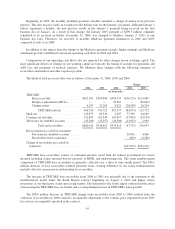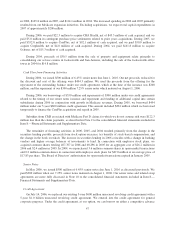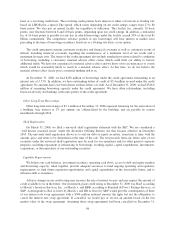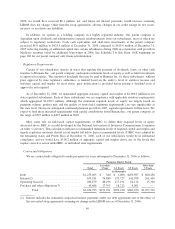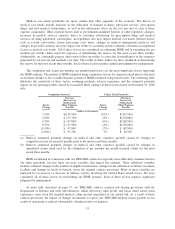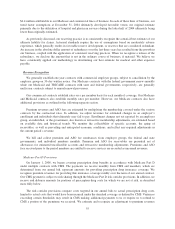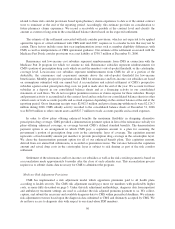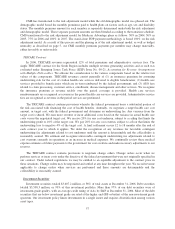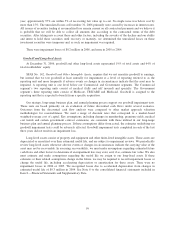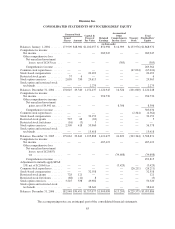Humana 2006 Annual Report Download - page 67
Download and view the complete annual report
Please find page 67 of the 2006 Humana annual report below. You can navigate through the pages in the report by either clicking on the pages listed below, or by using the keyword search tool below to find specific information within the annual report.
$4.4 million attributable to our Medicare and commercial lines of business. In each of these lines of business, our
trend factor assumptions at December 31, 2004 ultimately developed favorable versus our original estimate
primarily due to the utilization of hospital and physician services during the latter half of 2004 ultimately being
lower than originally estimated.
As previously discussed, our reserving practice is to consistently recognize the actuarial best estimate of our
ultimate liability for claims. Actuarial standards require the use of assumptions based on moderately adverse
experience, which generally results in favorable reserve development, or reserves that are considered redundant.
An increase in the absolute dollar amount of redundancy over the last three years has resulted from the growth in
our business, coupled with the application of consistent reserving practices. When we recognize a release of the
redundancy, we disclose the amount that is not in the ordinary course of business, if material. We believe we
have consistently applied our methodology in determining our best estimate for medical and other expenses
payable.
Revenue Recognition
We generally establish one-year contracts with commercial employer groups, subject to cancellation by the
employer group on 30-day written notice. Our Medicare contracts with the federal government renew annually
while our Medicaid and TRICARE contracts with state and federal governments, respectively, are generally
multi-year contracts subject to annual renewal provisions.
Our commercial contracts establish rates on a per member basis for each month of coverage. Our Medicare
and Medicaid contracts also establish monthly rates per member. However, our Medicare contracts also have
additional provisions as outlined in the following separate section.
Premium revenues and ASO fees are estimated by multiplying the membership covered under the various
contracts by the contractual rates. In addition, we adjust revenues for estimated changes in an employer’s
enrollment and individuals that ultimately may fail to pay. Enrollment changes not yet reported by an employer
group, an individual, or the government, also known as retroactive membership adjustments, are estimated based
on available data and historical trends. We monitor the collectibility of specific accounts, the aging of
receivables, as well as prevailing and anticipated economic conditions, and reflect any required adjustments in
the current period’s revenue.
We bill and collect premium and ASO fee remittances from employer groups, the federal and state
governments, and individual members monthly. Premium and ASO fee receivables are presented net of
allowances for estimated uncollectible accounts and retroactive membership adjustments. Premiums and ASO
fees received prior to the period members are entitled to receive services are recorded as unearned revenues.
Medicare Part D Provisions
On January 1, 2006, we began covering prescription drug benefits in accordance with Medicare Part D
under multiple contracts with CMS. The payments we receive monthly from CMS and members, which are
determined from our annual bid, represent amounts for providing prescription drug insurance coverage. We
recognize premium revenues for providing this insurance coverage ratably over the term of our annual contract.
Our CMS payment is subject to risk sharing through the Medicare Part D risk corridor provisions. In addition, we
receive and disburse amounts for portions of prescription drug costs for which we are not at risk, as described
more fully below.
The risk corridor provisions compare costs targeted in our annual bids to actual prescription drug costs,
limited to actual costs that would have been incurred under the standard coverage as defined by CMS. Variances
exceeding certain thresholds may result in CMS making additional payments to us or require us to refund to
CMS a portion of the premiums we received. We estimate and recognize an adjustment to premium revenues
55


